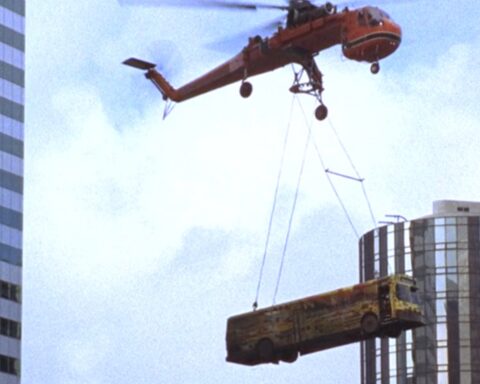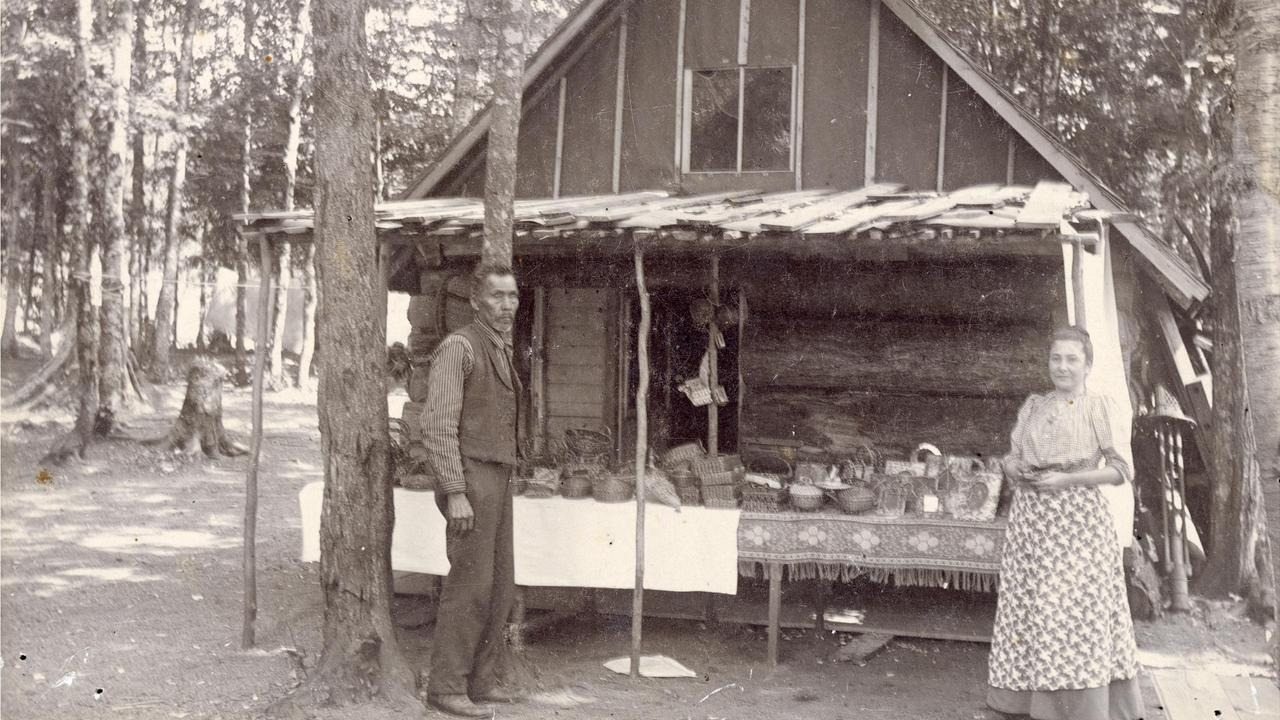A chorus of industry people circled the white glossy floors of the square atrium, entered and exited the coffee shops and theatres, and slid up and down the crisscrossing escalators as though performing in the silent opening dance sequence of a big-budget musical. Colm Feore strode through security ahead of me, and I blushed, unable to banish the memory of him in psychedelic spandex in an early ’90s staging of A Midsummer Night’s Dream. So this is the Toronto International Film Festival, I thought to myself. As if to confirm the point, Michael Moore waddled by, and a man in a suit turned to me, lifted his eyebrow, said, “the man himself,” and walked on.
It was Friday morning, and the festival was already a day and a half old. I’d picked up my press pass two days before, but a teaching gig and general terror had then set in. Each day the screenings started at 8:45 in the morning, and 60 films screened before the last one finished well after midnight. I spent the first morning sitting at home flipping madly between the press schedule and the catalogue of movie outlines. Every fifteen minutes I realized that, by reading another synopsis and not leaving for the theatre, I’d missed the start of yet another film. I wondered whether I would spend the whole week paralysed in my apartment while the year’s best movies screened just blocks away, and the last days of summer screened just outside my window. Finally, to my salvation, I discovered the first lesson of TIFF: not only can you not see everything, you cannot be interested in everything or you will go insane.
The only thing to do was get to the theatre and pick a movie. Soon enough what seemed like dozens of films had flashed before my eyes. The impressive dramas Persepolis and Contre Toute Esperance balanced out Harmony Korine’s vapid Mister Lonely; the diverting Margot at the Wedding offset the indulgent, masculinity-in-crisis stories of When Did You Last See Your Father and Closing the Ring. Though my faith in experimental cinema was shaken by Peter Greenaway’s vaguely disappointing Nightwatching, the artful gem You, the Living restored it, and had an entire audience shouting with laughter.
Interspersed among the films were large patches of waiting, either in line or between screenings, gaps in every day that seemed to provide their own film entertainment. One afternoon in line I had to my left a giant man in an elaborate bluegrass get up—hat, vest, suspenders, chaps, and an incongruous nose ring—and to my right a squat woman with a helmet of permed curls who pontificated from a chair on her love of art, her hatred of Greenaway, her respect for Helen Hunt’s new “old” look, and her entitlement to the first seat in the theatre. At one point Marilyn Manson strode past, turned to the left, posed, a camera clicked, and then he moved on at the clip of a diplomatic convoy.
Across the popcorn foyer of the theatre, Jake Gyllenhaal lounged against a railing looking for all the world like an off duty volunteer.
The real volunteers wore oversized orange tee-shirts that looked a little like hospital gowns, making the crowds of them, always mingling, bored silly outside the theaters, look like escaped extras from a teen remake of One Flew Over the Cuckoo’s Nest. One grizzled volunteer crouched in a corner and clutched her grey hair with a wide-eyed stare ahead, as though the idea that she’d never be a star had just tumbled down on her like wet cement. She looked so discouraged that for the rest of the festival I looked askance at the pre-film spots that declared NBC to be a “proud sponsor of the volunteer program.” Apparently the program worked so well that it recruited far more volunteers than necessary, so only a few had tasks at any given time. It seemed cruel.
Throughout all this activity I leaned against the wall for something to do while waiting. It vibrated as though a low-level earthquake was grinding away in the basement. I’d brought a book but couldn’t concentrate with so much bustle around me. Instead I thought about reading, and wondered why so many of the films I saw were based on books. The giant Indigo below the Varsity seemed to pose a question in the direction of the theatre. How many of the as-yet undiscovered novels inside the store would be screened at the festival in
coming years? Peter Greenaway has famously criticized mainstream cinema for illustrating literature instead of creating new stories on film, and indeed he continues to tell stories as much with images as with intricate dialogue.
In Canada, Guy Maddin’s work most notably answers this call for visual stories. Like the crazed brainchild of Anne Carson and Jean Cocteau, Maddin’s latest feature, My Winnipeg, wanders through a black and white Manitoba dreamscape of irony and nostalgia so rooted in images that it couldn’t possibly be translated into a different medium. I overheard one confident journalist proclaiming My Winnipeg to be the movie Michael Moore would make about his hometown “if he had an ounce of poetry in his soul.” In contrast, although Bruce McDonald’s The Tracey Fragments experiments with visual storytelling by building on the multiple- screen techniques of Time Code and The Pillow Book, like so many TIFF films, it’s based on a novel, and so isn’t as image- driven as My Winnipeg.
As the festival wore on, chatter about events after screenings began to filter down to me, and I discerned my second TIFF lesson: people who share the profession of cinema also share an overwhelming desire to go to cocktail parties. I began to wonder if parties and movies have something important in common. Luckily for my investigations, I got a third hand invitation to Guy Maddin’s party for My Winnipeg. Unfortunately, we arrived minutes after the friends who’d invited us, and we faced an unsympathetic bouncer at the door.
“What’s the name you have?” he asked us. We had nothing to say to him. Then my companion’s device buzzed in his hand. He glanced down. The text message read: “in case you forget, say Charlotte.”
“Charlotte,” he said.
“Charlotte’s a good name,” said the bouncer, removing the chain. Once in, we tried but couldn’t be sure that TIFF had made the same old bar experience even better. In no way did this party improve on My Winnipeg itself.
Later in the week the Italian Trade Commission held a party in Lower Bay subway station. Used by the public for only six months, film companies rent it for shoots, and at all other times it haunts Upper Bay station like a mad wife in the attic. A red carpet at the Yorkville entrance to the station greeted partygoers in an ironic gesture towards the difference between the limousine world and the regular world of public transit.
Eager to see the sights, I left my friends chatting in a busy bar car to take a turn about the station. No sooner had I stepped from the car than a woman, rushing as though to catch the subway, hammered into my brimming glass of red wine, which, lacking a convenient plastic lid, was not subway-proof. The wine splashed all over yet another woman’s white silk pants and shoes. I wished I could have told her off for wearing white after Labour Day. Instead, terrified of spilling more wine on Italian gliterati, I returned to our car.
“A woman just came into the train yelling about the girl who spilled red wine all over her pants,” murmured my companion. “I knew you were involved.”
Contrite, I slipped out again, wondering whether coming to this party was really worth missing a movie. Many festival-goers seem willing to exchange a film for a party, but why, I wondered, is the cocktail party preferable? I plopped down on a chunky wooden platform bench to mull things over. The standard TTC seating had been replaced with New York subway furniture. In general, a party is more rare than a film, which can be replayed, but at the festival, where many of the films are likely to never receive local distribution, a missed film can be as irretrievable as last week’s party. Parties are delightful because they allow you to stare at strangers, and, by looking at a person, you can learn a bit about where she’s been and where she’s going. The image of a face contains a trajectory, and so, unlike words, tells a story instantly. While movies make you sit through the same story for two hours, at a party you can choose which characters to sidle up to, and who to dismiss after ten minutes of boring conversation. The cocktail party is an intersection of a hundred stories, while a traditional movie has only one linear narrative. Maybe parties are better than films because they hold so many more stories, and let you choose which one to follow. In addition to the networking perks, not to mention the appeal of free booze, maybe film festival- goers like cocktail parties so much because they provide a more intense version of the cinematic experience that has brought them together.
With this discovery ringing in my head, the next day I went to see the joint NFB–CFC (National Film Board- Canadian Film Centre) production Late Fragment, North America’s first interactive feature film. With breathtaking cinematography, the movie tells the story of three characters with parallel lives: each has witnessed a horrific event; each suffers from a traumatic memory. They have come together to escape the past by telling their stories in a restorative justice session inside a jail, but the revolving sequence of clips begins to show that the patterns of guilt and thwarted love that connect them are labyrinthine, and threaten to trap them permanently. Viewers modify their experience of the film by clicking the remote at will, thereby accelerating, switching, or replacing scenes according to an elaborate set of pathways programmed into the DVD. Since clicking the remote alters the pace and order of the clips, viewers themselves become members of the characters’ dark story-telling circle.
By allowing viewers to change the film while watching, Late Fragment bridges the gap between video games and film, and fulfils the current trend towards user-driven entertainment. In addition to pushing the field of interactive cinema one important step further, the many collaborators on Late Fragment have also made a major contribution to Canadian cinema. Late Fragment may be the most groundbreaking of the films screened at TIFF this year, but classified with the series of video installations, its screening times weren’t properly listed in the schedule, and many festival staff didn’t even know about it. TIFF didn’t seem quite ready for interactive film.
Inspired by the interactivity of Late Fragment, I decided to make my viewing experiences for the rest of the festival more like parties, and started skipping between films. Denys Arcand’s film L’Âge des ténèbres began one hour before François Girard’s Silk. Thinking that films by two acclaimed French-Canadian directors would make an interesting double header, and reluctant to miss either movie, I decided to start with Arcand, and step out to Silk if I felt bored.
Eschewing the complex and compassionate relationships Arcand’s earlier films produce so deftly, L’Âge des ténèbres plods through one character’s gently ironic malaise as he stumbles among imaginary concubines who accost him and demand sex. After an hour I left to catch Silk. At a budget of 25 million, Silk_’s story is as empty and unrealistic as its landscapes are exquisitely rendered. Without the depth or diversity of _The Red Violin and 32 Short Films About Glenn Gould, Girard’s latest feature progresses with the flaccid logic of a dream. Great distances are covered overland nearly instantly, and dialogue is laboured and unconvincing. Most unbelievable of all, a man who is married to Keira Knightly falls in love with another woman because she looks him in the eye, once, and then fondles him silently from behind in the bathtub before giving him a note he can’t read.
Suddenly both Girard and Arcand’s films seemed trapped in the same straight male fantasy of blank women dropping their panties without speaking their minds. I know a few women who look like the spinal cords with jugs and cheekbones in these movies, and none are likely to lift their shirts for someone they just met. Even Keira Knightly admitted to being unable to understand her character’s unconditional love for her dud husband. That Silk found 25 million dollars in backing is a sign of how far feminism in film still has to go. I started laughing at an especially ponderous moment and so left, regretting not watching Arcand’s film to the end: at least his fantasy had irony.
Late on the last night of screenings, I went to Woody Allen’s Cassandra’s Dream for an hour before skipping out to Glass: A Portrait of Philip in 12 Parts, a documentary on the composer Philip Glass. Allen’s uncharacteristic choice of a dark and brooding Glass soundtrack for Cassandra’s Dream gave the movie a markedly different tone from his usual jazz-inflected work, and there was a strange delight in leaving the film to peer at the face behind the score. At one point in the documentary Glass chats with Allen after playing him Cassandra’s soundtrack for the first time. Like Dorothy from The Wizard of Oz, I’d stepped behind the screen to peer at the man operating the light and sound machine. The documentary cut away the glitz and returned an honest portrait of an artist working behind the façade of cinema. His story seemed at once more complex, subtle, and in some ways as powerfully dramatic as any fictional tale on screen at the festival.
And then that was all. There were no more films, no more parties. As I left the theatre the cold night air announced that summer had ended while I was watching movies. Still bitterly disappointed by Girard’s film, I thought of a winter evening three years ago when I made my American friend Mimi sit down and watch The Red Violin. A few weeks ago she told me that the film inspired her to go after the competitive job she now has at a major auction house in New York. By no means would Girard’s latest work propel a smart girl to aspire to do anything for herself.
Made well, however, films can be such good mirrors that in reflecting life back at us they translate into reality, and push people through the looking glass to make their lives more like movies. The best films screen the switching, modifiable, infinite experience of real life while doing us the favour of keeping the hassle of its friction, awkwardness, and red wine spilt on white pants at a distance. Stepping onto the subway I imagined a red carpet unfurling before the giant cinematic cocktail party stage of life post-festival. The guestlist is open.












